|
Russia

The Rifle Mosin or it's
western name, the Mosin Nagant rifle owes it's beginnings to the
circumstance of modern warfare. The advent of the repeating rifle led
the Russian Imperial government to start a search for a replacement for
their antiquated Berdans. A commission was established to find a design
that would compete with the Mauser, Lebel, Lee-Metford,
Mannlicher, Schmidt-Rubin and the Krag-Jorgensen. They could
have never imagined that the result of their efforts would see service
in battle for the next 80 years while the other rifles became museum
pieces. A Russian army Captain, Sergei Ivanovich
Mosin would eventually produce the winner of the competition for a new
design. 
Mosin's rifle wasn't an
overnight success. He began work on the design in 1883. His primary
focus was on the development of a magazine fed infantry rifle. He
submitted several designs for internal fed magazine rifles to the
commission in 1884 and 1885. His initial designs were in 10.6
mm. Between 1887 and 1889, working with the smaller caliber
then coming into general use among European armies, Mosin developed a
5-shot, straight-line magazine prototype in 7.62 mm; employing the
antediluvian Russian measurements of the era it was designated 3-line
caliber. The liniya, or line is equivalent to 0. 10 in or 2.54 mm;
therefore, 3 linii equals 7.62 mm or .30 in.(Lapin, "The Mosin Nagant
Rifle")
All of his efforts were
rejected until October 1889. The Belgian weapons designer Leon Nagant
submitted his 3.5 line (8.89 mm) rifle and 500 rounds of ammunition for
testing by the Russian government. Both designers' weapons were tested
from 1890 through 1891 by units of the Russian Army. Initially, the
home team headed by Mosin lost as the army favored Nagant's design.
However, Russia being Russia, the votes were overturned in favor of
Mosin. The reason behind this move was most likely political. Typical
of Russian ingenuity and political deftness, both designs were
incorporated into a rifle that featured the Mosin model with the Nagant
designed feed system. This rifle was designated the Pekhotniya vintovka
obr. 1891g. or Three-Line Rifle of the year 1891.
Pekhotniya
vintovka obr. 1891g.
(Model 1891 Three-Line Rifle)

Photo Courtesy of Empire Arms
A number of changes were made
to the M1891 in the years up to about 1910. Many of these changes were
the result of Russia's adoption of the M1908 spitzer bullet whose
ballistics required or made advisable certain changes to the entire
weapon. Whether the changes occurred in 1909 or 1910, or both, is still
uncertain. The steel finger rest behind the trigger guard was
eliminated in 1894. New barrel bands were introduced which fitted flush
with the underside of the stock rather than protruding below the stock
as the earlier type did. A hand guard was added. Sometime between 1908
and 1910 a convex rear sight leaf was designed by V. P Konovalov, of
the Sestroryetsk Arms Factory. Many sources link this change with the
introduction of the Spitzer bullet and it's greater accuracy. (John
Walter, Rifles of the World)
The original rear sight had
graduations marked on the left side of the sight base from 200 to 1000
arshini (1 arshin = 710 mm, or about 28 in). In the 1920s, after the
Soviets adopted the metric system, the sights were re-marked in meters
as well, in increments of 200. Also in 1909 or 1910 a metal
bolt was added through the rear of the finger groove to strengthen the
stock against the effects of recoil. The sling swivels, that attached
under the forward barrel band and at the front end of the magazine,
were replaced around 1910 by slots cut through the stock between the
barrel bands and midway between the butt and the trigger-guard and
lined with metal washers. This conversion to sling-slots resulted in
using a sling assembly consisting of two leather straps resembling a
dog collar through which the sling it's self was fastened. In the years
between 1892 and 1908 the Russian Army took delivery of 313,375 M1891
Infantry rifles and an additional 54,235 training rifles. (Lapin, "The
Mosin Nagant Rifle") Some of these training rifles are rumored to be
showing up on the surplus market today in a single shot configuration.
Data & Facts
Produced from 1891 to 1928
Arsenals - Tula, Ishevsk,
Sestroretsk,Chatterault, Westinghouse, Remington
Initially produced without a
hand guard
Sling initially attached from
a hanger on front barrel band to a hanger attached to the front of the
magazine. On later models the sling attached through a slot cut in the
fore stock using leather collars and a slot in the butt stock. The M91
is often found with the Imperial markings defaced. This was done after
the Soviet revolution.
Stats
Length: 1288 mm w/out bayo
Weight (unloaded): 4.06kg
Barrel: 760mm, 4 groove,
right-hand twist
Magazine: 5 round integral box
Rate of Fire: Bolt-action, 10
- 12 rounds per minute
Caliber: 7.62x54Rmm
vintovochnyi patron obr 1891g
Muzzle Velocity: 615mps
Dragunskaya
vintovka
(Model
1891Three-Line Cossack Rifle)
&
Kazachya I dragunskaya vintovka
(Model
1891Three-Line Dragoon Rifle)

91 Kosak 1896 Ishevsk
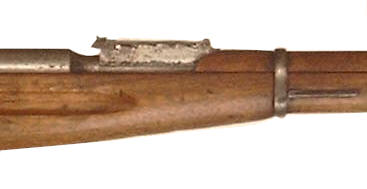
photo from K-H Wrobel

91 Dragoon 1904 Ishevsk
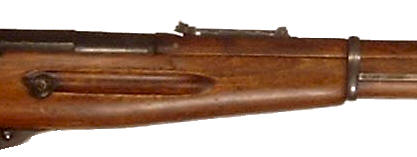
photo from K-H Wrobel

91 Kosak 1918 Ishevsk

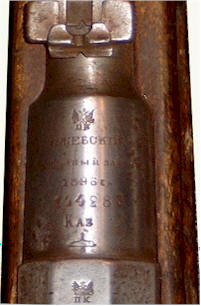
KA3 Marking
photo from K-H Wrobel
Data & Facts
Dragoon Rifle
(драгунская)
— Intended for use by Dragoons (mounted infantry). 64 mm
(2.5 in) shorter and 0.4 kg (0.9 lb) lighter
than the M1891. The Dragoon rifle's dimensions are identical to the
later M1891/30 rifle, and most Dragoon rifles were eventually reworked
into M1891/30s. Most such rifles, known to collectors as "ex-Dragoons",
can be identified by their pre-1930 date stampings, but small numbers
of Dragoon rifles were produced from 1930 to 1932 and after reworking
became impossible to distinguish from purpose-built M1891/30s.
Cossack Rifle
(казачья)
— Introduced for Cossack horsemen, it is almost identical to the
Dragoon rifle but is sighted for use without a bayonet.
Lapin writes, "The "Cossack" (kazach 'ya) version was introduced for
those horse borne gentlemen in the later 1890s. It was almost identical
to the dragoon model but originally had a flat rear sight leaf similar
to that of the M1891/30. This sight was changed with the adoption of
the M1908 spitzer bullet, and was thereafter a saw tooth ramp-and-leaf
sight almost identical to that of the Dragoon. Unlike the Infantry and
Dragoon models, the Cossack rifle was sighted to be used without a
bayonet as they were not issued with this weapon. The Cossacks were
traditionally armed with sabers. One report states that the Cossack
model was originally produced fully-stocked, as was the M1907 carbine,
but the author has been unable to find any evidence for this claim. The
Cossack rifle was initially made without the reinforcing bolts in the
stock, but rifles made in and after 1909 did have the reinforcing
bolts. It is also possible that older weapons were retrofitted with the
bolt after adoption of the new cartridge." Cossack rifles are
recognized by the letters Kaz, just below the serial number.
Stats
Length: 1218 mm w/out bayo
Weight (unloaded): 3690 kg.
Barrel: 730mm, 4 groove,
right-hand twist
Magazine: 5 round integral
box
Rate of Fire: Bolt-action,
10 - 12 rounds per minute
Caliber: 7.62x54Rmm
vintovochnyi patron obr 1891g
Muzzle Velocity: 615mps
Karabina
obr. 1907
(Model 1907 Carbine)

Data
& Facts
Produced from 1910 - 1917
Arsenals - Ishevsk
Often mistakenly called the
Carbine 1910 because of some minor improvements made that year. Rear
sight is very short and marked from 400 -2000 arshini.
The Model 1907
Carbine is one of the most controversial models sought after
by collectors. The M1907 carbine is often mistakenly referred to as the
M1910 Carbine. There were a number of changes were made to the carbine
around 1910, but it was never designated M1910 . The M1891 was too long
and too heavy for engineers, artillerymen and signalers to carry and
the cavalry found the M1891 rifle awkward on horseback. "As early as
1895 a carbine (karabin) prototype was developed, reportedly by
altering the dragoon rifle. Introduced in 1907 the carbine, at 40 in
and 7.6 Ibs, was 11.37 in shorter and 2. 1 lbs. lighter than the
infantry rifle Pekhotniya vintovka. The carbine was stocked almost to
the front sight and thus did not take a bayonet. The M 1907 carbine has
a rear sight with graduations of 400 to 2,000 arshini (about 312 to
1,560 yards)." (Lapin, "The Mosin Nagant Rifle")
Production of new carbines
was undertaken at the Izhevsk factory, and existing Dragoon and Cossack
rifles were altered to carbines at Sestroryetsk using a system
developed by N. I. Yurov.
Soviet-era, arsenal-reworked
carbines are on the market which have tsarist-era dated hexagonal
receivers, and are advertised as M1907 or M1910 carbines. Genuine
M1907s are rare finds at the local gun show should be very carefully
examined before buying. Make sure you check out the rear sight, front
sight, hand guard, and stock.
Stats
Length: 1015mm
Weight (unloaded): 3276 kg.
Barrel: 508mm, 4 groove,
right-hand twist
Magazine: 5 round integral box
Rate of Fire: Bolt-action, 10
- 12 rounds per minute
Caliber: 7.62x54Rmm
vintovochnyi patron obr 1891g
Muzzle Velocity: 560 mps
Vintovka
1891/30
(Model
91/30 Rifle)
Type I
& Type II
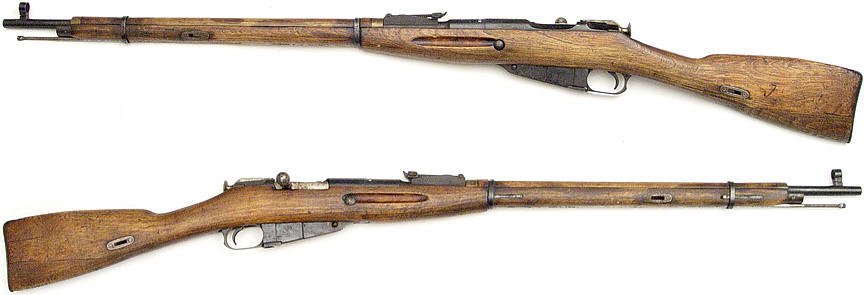
photo contributed by Empire Arms

Data
& Facts - Type I
Produced from 1927 -1932 (
some later dates have been seen)
Arsenals - Ishevsk, Tula
Uses Dragoon stock and has a
blade type front sight. Some retained the Dragoon rear sight marked in
Arshini.
Data
& Facts - Type II
Produced from 1933 - 1944
Arsenals - Ishevsk, Tula
Improved front and rear
sights and used a spring type barrel band retainer. Produced mainly
with a round receiver after 1938.
The Model 1891/30 Rifle
(Vintovka obr. 1891/30) was commissioned by the Revolutionary Military
Council of the Workers' and Peasants' Red Army. Early in 1924 a
committee consisting of Ye. K. Kabakov and I. A. Komaritskii, began
work on modernizing the M1891, using the dragoon model as a basis. The
first trial rifles were made in 1927 and by 1930 a new design had been
agreed upon, which was standardized on 28 April as the "Rifle Model
1891/30" (vintovka obrazers 1891/30goda.) Production of the M1891/30
began on 10 June 1930 at Tula and Izhevsk and ceased at Tula
in the spring or summer of 1942 . Izhevsk discontinued production in
1944. Because supplies of M1891 parts (barrels, receivers, stocks,
etc.) were in great supply, some M1891/30s were still being made with
hexagonal receivers as late as mid-1936.
The story of the M91/30 can't
be told without mentioning the trials and tribulations of the arsenals
that produced it during the Great Patriotic War or W.W.II. The Soviet
Union was able to produced a sufficient amount of weapons on a wartime
footing to equip it's massive army while in some cases moving that
production hundreds of miles and maintaining their output in crude
facilities that often times were nothing more than a bombed out tractor
factory. Izhevsk and Tula were fortunate to remain behind soviet lines
during the war. Although Tula was threatened at one point. On the other
hand was forced to cease production in 1941 due to the approach of
Finnish troops. The entire operation was relocated to Leningrad where
it resumed production. There are conflicting stories about this though.
Karl-Heinz Wrobel indicates that Sestroryetsk discontinued their
weapons production long before the war. However, A number of SVT40's
appeared on the US market in the past few years with what was believed
to be Sestroryetsk arsenal marks. A story has emerged that this is the
Kirov mark. However, I can not find any documented evidence of Kirov
being an official state arsenal. There is some mention of an arsenal
being relocated there but Tula and Izhevsk never moved. I can only
surmise that the Soviets installed the equipment from Sestroryetsk
there to produce SVT's and the arms makers used the Sestroryetsk mark.
M91/30's were produced using
both the older hex receivers as well as the more modern round
receivers. Those produced during the height of the war had at least two
distinguishing features: extremely rough milling on the receiver and a
high receiver wall on the left side of the receiver. Both of these
measures were intentional to cut down on the milling process and to
expedite the guns to the front line soldier.
Stats
Length: 1218mm
Weight (unloaded): 3890 kg.
Barrel: 730 mm, 4 groove,
right-hand twist
Magazine: 5 round integral box
Rate of Fire: Bolt-action, 10
- 12 rounds per minute
Caliber: 7.62x54Rmm
vintovochnyi patron obr 1891g
Muzzle Velocity: 860 mps
Snayper
vintovka obr. 1891/30g.
(Model
91/30 Sniper Rifle)
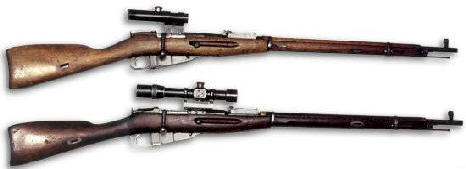
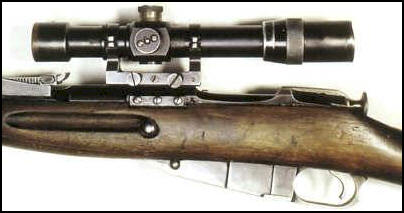
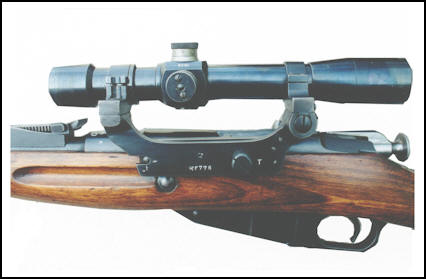
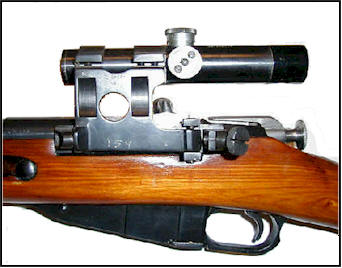

K-H Wrobel Collection
(See the Sniper Section)
Data
& Facts
Type PE Produced from 1931-
1936
PEM 1937-
1942
PU 1942 - 1958
Arsenals - Ishevsk, Tula
PE/PEM used a longer scope
using optics initially made by Zeiss. Type PU is more common.
A sniper variant of the
M91/30 was also produced and competed in the field with the Tokarov
SVT40 for the main sniper rifle of the Soviet forces. Even though the
SVT was newer and a semiautomatic to boot, the M91/30 sniper eventually
won out as the preferred sniper rifle.
Stats
Length: 1218mm
Weight (unloaded): 3890 kg.
Barrel: 730 mm, 4 groove,
right-hand twist
Magazine: 5 round integral box
Rate of Fire: Bolt-action, 10
- 12 rounds per minute
Caliber: 7.62x54Rmm
vintovochnyi patron obr 1891g
Muzzle Velocity: 860 mps
Karabina
obr. 1938g.
(Model
1938 Carbine)

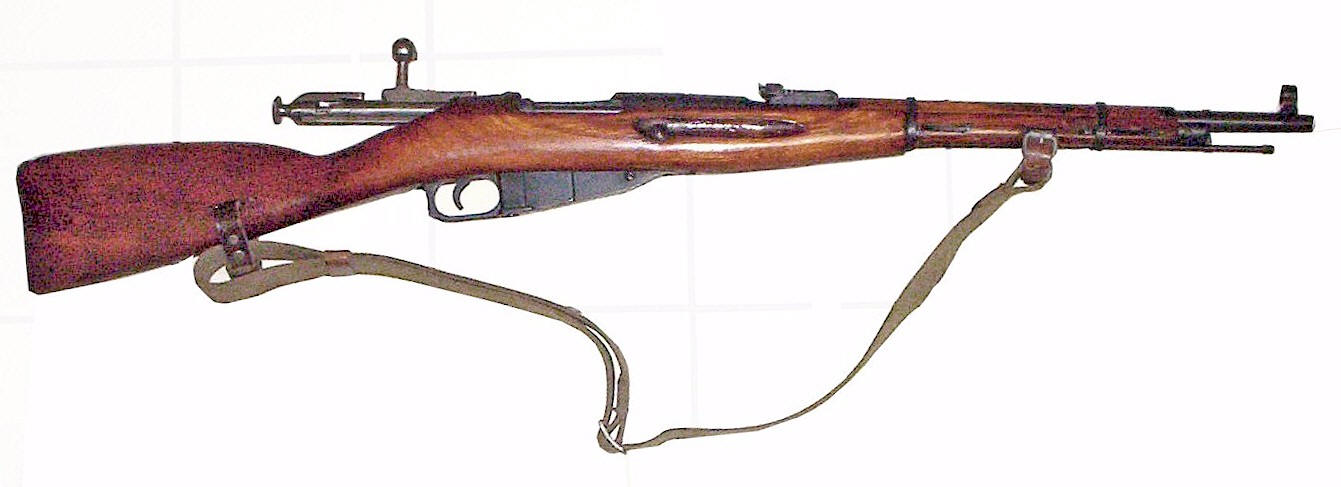
Data & Facts
Produced from 1938 - 1944
Arsenals - Ishevsk,Tula
Rear sights marked from 100
to 1000 meters. Some models are found using M44 Carbine stocks.
Even though the M91/30 was
shorter than the M1891, cavalry, artillery, signalers, and
other support units still required lighter, less bulky weapons. Drawing
from the role of the M1907 carbine, the Soviets adopted a new carbine,
the M38 which was officially entered into the inventory in 1939. This
model differed from the M1907 in that it was not fully-stocked and used
the new hooded-post front sight as found on the M1891/30 rifle. The
M1938, like its predecessor, did not accept a bayonet and had an
improved rear sight graduated in 100s of meters, indicated by the
numerals 1 through 10, stamped on the rear sight leaf. The M1938 was
produced from 1939 to 1945, it was replaced by the M1944.
Stats
Length: 1020mm
Weight (unloaded): 3276 kg.
Barrel: 517mm, 4 groove,
right-hand twist
Magazine: 5 round integral box
Rate of Fire: Bolt-action, 10
- 12 rounds per minute
Caliber: 7.62x54Rmm
vintovochnyi patron obr 1891g
Muzzle Velocity: 820 mps
Karabina obr. 1944g
(Model 1944 Carbine)
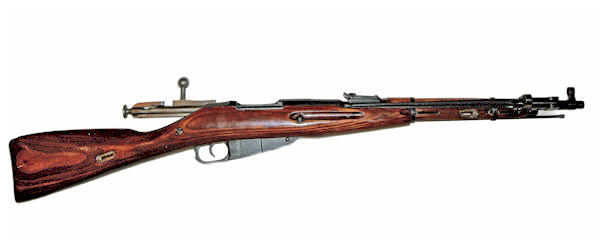


K-H Worbel Collection
Data
& Facts
Produced from 1943 - 1948
Arsenals - Ishevsk,Tula (Tula
M44's considered rare)
War year models feature a
bayonet mount with one "ear" - post war has two. Many war year
production M44's had laminated stocks.
The M/44 was the natural
extension of the M38 carbine. Soviet battle experiences showed that the
M91/30 was still too long of a rifle to be practical in urban and
confined war fighting environments. Bolotin, in his book, Soviet Small
Arms and Ammunition -reported that a number of requests had been made
for an improved infantry weapon. Several sources indicate that although
a carbine was desired, the troops wanted to also have the benefit of
being able to utilize a bayonet. Unlike the M91/30, the Soviets came up
with a unique solution, a side mounted, permanently affixed folding
bayonet. The bayonet was a cruciform spiked affair with a point shaped
like a screw driver. It was extended by pulling down on the guard and
rotating it up and letting it seat on the muzzle. To collapse it, one
simply pulled it up and rotated it back into it's stored position on
the right side of the weapon.
The M/44 stock was mostly a
shortened version of the M91/30 and later was produced in a laminated
version. Production of the carbine was started in 1943 for prototypes
and trials, and continued under license in the satellite Soviet states
and China well into the 50's. By 1944, the development of the 7.62x39mm
M43 round was underway and new auto-loading rifles were making their
appearance. The Model 1944 features a folding bayonet that replaced the
detachable type on older models. As late as the Viet Nam War, the Type
53 (Chinese) was standard issue to the Viet Cong. Polish examples of
this rifle were captured in Granada during the invasion by U.S. Troops.
More recently, M44's have seen service in the Balkans and Chechnya as
well as during the Soviet occupation of Afghanistan.
Stats
Length: 1020mm
Weight (unloaded): 3850 kg.
Barrel: 517mm, 4 groove,
right-hand twist
Magazine: 5 round integral box
Rate of Fire: Bolt-action, 10
- 12 rounds per minute
Caliber: 7.62x54Rmm
vintovochnyi patron obr 1891g
Muzzle Velocity: 820 mps
Karabina obr. 9159g
(Model
91/59 Carbine)

Photo from JYD Collection
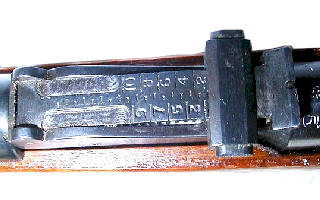
Data & Facts
Produced in 1959
Arsenals - Ishevsk ( I have
heard of one Tula example )
Made from 91/30's.
Produced for the Reserve Police.
The 91/59 Carbine was at
first believed to be produced in the former Warsaw Pact but evidence
has surfaced that points to the former Soviet Union as these rifles
were used by internal security and border patrol units. Essentially,
the 91/59 is a carbine length rifle made from M91/30 barreled receivers
and mated with an M44 stock. One distinctive feature is the rear sight
which is a standard 91/30 sight with the sight increments milled
off.
Stats
Length: 1010 mm
Weight (unloaded): 3850 kg.
Barrel: 517mm, 4 groove,
right-hand twist
Magazine: 5 round integral box
Rate of Fire: Bolt-action, 10
- 12 rounds per minute
Caliber: 7.62x54Rmm
vintovochnyi patron obr 1891g
Muzzle Velocity: 820 mps
|

